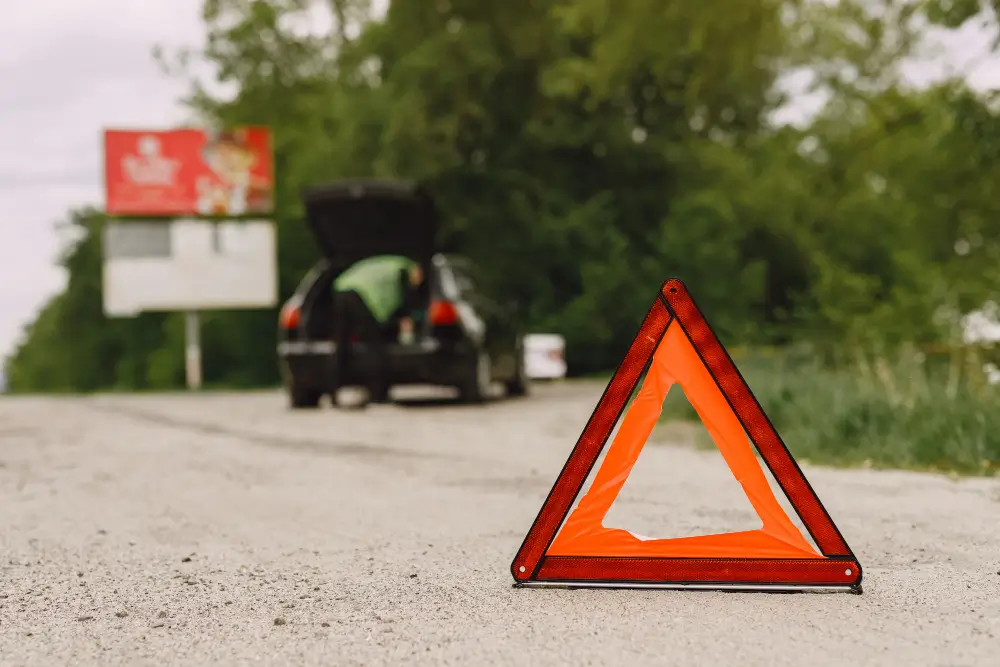That moment when your vehicle decides to quit, always at the worst possible time and place. In Cary’s growing traffic landscape, knowing where to safely pull over during a vehicle emergency isn’t just convenient—it’s critical. Local traffic safety reports indicate that roadside emergencies are common throughout the Triangle area, with many drivers putting themselves at risk by stopping in unsafe locations.
At Agile Towing Company, our 24-hour roadside assistance team at (919) 276-5900 has responded to countless emergency situations throughout Cary. We’ve seen firsthand how your stopping location directly impacts both your safety and assistance response time.
This guide will show you what makes a safe emergency stopping location, specific places to pull over on Cary’s major highways and busy roads, areas to avoid during vehicle emergencies, and the essential next steps after you’ve found a safe spot.
What Makes a Safe Emergency Stopping Location in Cary?
Safety during a roadside emergency starts with where you choose to stop your vehicle. Not all roadside areas offer the same level of protection or visibility to other drivers.
Key Characteristics of Safe Emergency Stopping Areas
The ideal emergency stopping location provides several critical safety features:
- Sufficient distance from traffic: Look for areas where you can put at least 10-15 feet between your vehicle and passing traffic. This creates a buffer zone that reduces the risk of being struck by passing vehicles.
- Visibility to other drivers: Other motorists should be able to see your vehicle from at least 200 feet away, giving them adequate time to adjust their driving. Stopping just after a blind curve or at the crest of a hill creates dangerous situations where approaching drivers have little time to react.
- Solid, level ground: Your vehicle should be on stable, preferably paved surface. Soft shoulders, especially after rain, can cause your vehicle to sink or become stuck, complicating recovery efforts.
- Good lighting (especially at night): Well-lit areas improve your visibility to other drivers and enhance your personal safety. They also make it easier for roadside assistance technicians to perform necessary repairs or prepare your vehicle for towing.
- Cell phone reception: While most of Cary has good coverage, some pockets along highways or in lower-lying areas may have spotty service. Being able to call for help is crucial during an emergency.
The right emergency stopping location balances all these factors, potentially turning a dangerous situation into merely an inconvenient one.
Designated Emergency Stopping Areas on Major Highways Around Cary
Cary’s position in the Triangle means many residents regularly travel on major highways where vehicle speeds make emergency situations particularly dangerous. Knowing specific safe locations can be lifesaving.
I-40 Emergency Stopping Locations
I-40, which runs along the southern edge of Cary, has several designated safe areas:
- Emergency pull-off areas: Located approximately every 2-3 miles, these widened shoulder sections are specifically designed for disabled vehicles. They’re marked with signs and provide extra space between your vehicle and passing traffic.
- Rest areas: The closest to Cary is the Travel Information Center at mile marker 295, which offers safe parking, restrooms, and usually security presence.
- Service exits: The Aviation Parkway (exit 285), Harrison Avenue (exit 287), and NC-54/Chapel Hill Road (exit 290) exits all have gas stations and service areas within a quarter-mile of the exit ramp, providing safe havens during emergencies.
When using highway shoulders as emergency stopping locations, pull as far right as safely possible. Turn on your hazard lights immediately, and if it’s dark, try to illuminate the area around your vehicle.
I-440/Beltline Safe Areas
The Beltline around Raleigh, which connects to Cary via I-40, has several safe stopping options:
- Widened shoulders: Between exits 1 and 3, several sections have wider-than-normal shoulders designed specifically for emergency stopping.
- Exit ramps: When possible, try to reach an exit ramp where you can safely pull to the side, away from main traffic flow.
- Service stations near exits: The Walnut Street and Western Boulevard exits both have service stations visible from the highway that provide safe stopping locations.
US-1/US-64 Options in Cary
These major routes through Cary offer several emergency stopping options:
- Dedicated pull-offs: Several exist between the Walnut Street and Tryon Road interchanges.
- Shopping center entrances: The Crossroads Plaza and Cary Towne Center areas have wide entrance roads where you can safely pull over without blocking traffic.
- Service stations: Numerous gas stations along these routes provide safe havens during vehicle emergencies.
Remember that your location matters for emergency responders. Highway markers and mile posts are the most precise way to communicate your position when calling for assistance. Make note of the nearest mile marker or exit number when you stop.
Safe Places to Stop on Cary’s Busy Roads
Not all emergencies happen on highways. Cary’s busy local roads present their own challenges for finding safe emergency stopping locations.
Cary Parkway Emergency Options
Cary Parkway, one of the town’s main thoroughfares, offers several good emergency stopping locations:
- Shopping center parking lots: The Parkway contains numerous shopping centers with parking lots set back from the main road, including those at High House Road, Old Apex Road, and Kildaire Farm Road intersections.
- Church parking lots: Several churches along Cary Parkway have large, accessible lots that provide safe havens during daylight hours.
- Wide median sections: In some stretches, particularly between Evans Road and Harrison Avenue, the median is wide enough to provide temporary safe haven if you cannot make it to a parking lot.
Kildaire Farm Road Safe Zones
This busy north-south corridor offers several emergency stopping options:
- Gas stations and convenience stores: Multiple locations, particularly near the Maynard Road and Tryon Road intersections, provide safe pull-off areas.
- Office complex entrances: The office parks between Maynard Road and High House Road have wide entrance drives suitable for emergency stopping.
- Municipal parking lots: The Cary Town Hall and adjacent public facilities have accessible parking areas just off Kildaire Farm Road that provide safe stopping locations.
When stopping on busy local roads, always activate your hazard lights immediately and try to position your vehicle completely out of travel lanes if possible.
Areas to Avoid When Having a Vehicle Emergency in Cary
Some locations significantly increase risk during vehicle emergencies and should be avoided whenever possible, even if it means limping your vehicle a short distance further.
The most dangerous places to stop include:
- Blind curves: Particularly problematic on roads like Davis Drive and portions of High House Road where visibility is limited.
- Narrow shoulder sections: Parts of Green Level Church Road and sections of NW Maynard Road have minimal shoulders that don’t provide adequate separation from traffic.
- Bridge decks: The bridges over the railroad tracks on Harrison Avenue and Maynard Road have no shoulders and limited visibility.
- Active construction zones: Temporary lane shifts and narrowed roadways, like those frequently found on I-40 and US-1, create unpredictable traffic patterns that increase risk.
- Flood-prone areas: Low-lying sections near Swift Creek and other drainage areas can become hazardous during heavy rain.
If you absolutely must stop in a less-than-ideal location, maximize your vehicle’s visibility with hazard lights, reflective triangles if available, and by raising your hood to signal distress.
What to Do After Finding a Safe Emergency Stopping Location
Once you’ve secured a safe location, taking the right next steps helps ensure your continued safety and expedites assistance.
First, enhance your visibility to other drivers. Turn on hazard lights immediately, and if you have reflective triangles or flares (maintaining appropriate safety precautions with the latter), place them about 50 feet behind your vehicle.
The decision to stay in or exit your vehicle depends on circumstances. Generally, if you’re on a high-speed road like I-40 or US-1, remaining inside with seatbelts fastened is safest. If you must exit, do so from the passenger side, away from traffic.
When calling for assistance, provide your exact location. This is where advance knowledge of emergency stopping locations in Cary becomes invaluable. Reference specific landmarks, mile markers, or nearby businesses. Most smartphones can provide GPS coordinates through mapping apps, which roadside assistance dispatchers can use to pinpoint your location.
If you’re using our services at Agile Towing Company, our dispatchers are familiar with all major emergency stopping locations in Cary and can guide responders directly to you once they understand your position.
Conclusion
Vehicle emergencies are stressful enough without the added worry of where to safely pull over. By familiarizing yourself with emergency stopping locations in Cary before trouble strikes, you’ll make better decisions in the moment, significantly increasing your safety and reducing response times for assistance.
Remember that the best emergency stopping locations provide adequate distance from traffic, good visibility, solid ground, appropriate lighting, and reliable communication access. Whether you’re on I-40, the Beltline, US-1, or one of Cary’s busy local roads like Cary Parkway or Kildaire Farm Road, knowing specific safe stopping options in advance transforms a potential crisis into a manageable situation.
At Agile Towing Company, our 24-hour roadside assistance team at (919) 276-5900 is always ready to help during vehicle emergencies. We respond faster and more effectively when you’ve chosen a safe, accessible location and can clearly communicate where you are.
Take a few minutes during your next few drives around Cary to identify and mentally note safe emergency stopping locations along your regular routes. This simple preparation could make all the difference during your next unexpected roadside situation.


